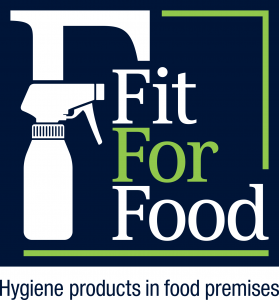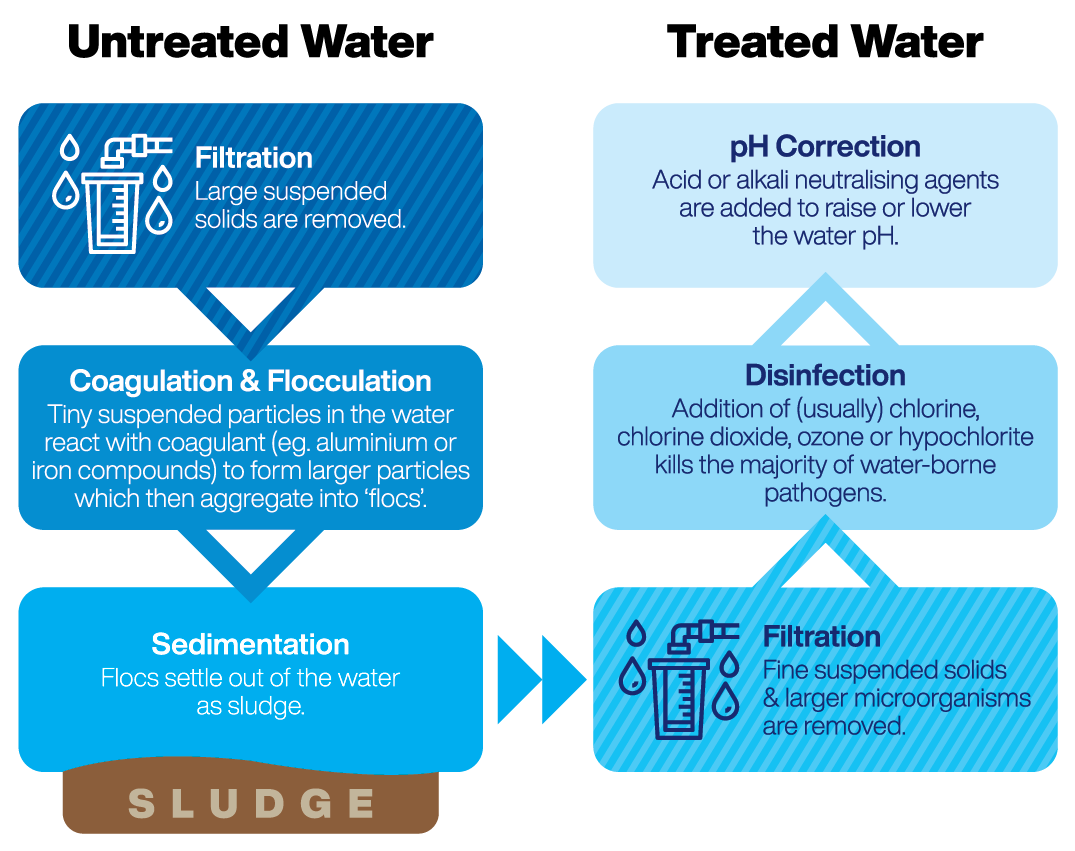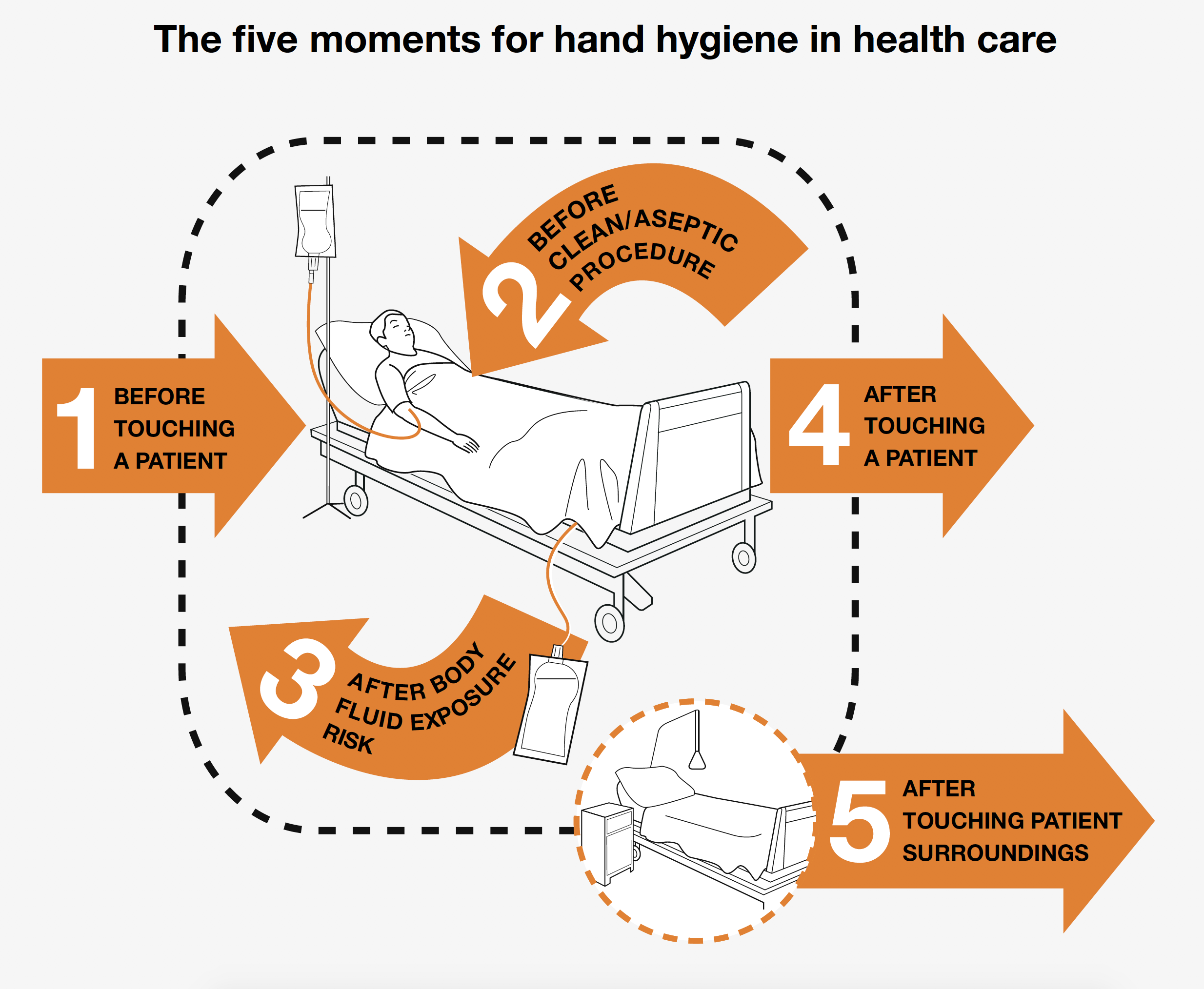Good hygiene “out and about” keeps the places you go clean, hygienic and comfortable.
Think of all the places you go – restaurants, schools and universities, shopping centres, the office or factory… Have you thought about everything that goes into keeping these places hygienic?
Some hygiene products are designed specifically for commercial, public and institutional applications. These products play a vital role in keeping these areas clean and comfortable. In certain areas, such as hospitals and food service, hygiene becomes even more vital to protect human health, ultimately saving lives and decreasing the burden on Australia’s health system.
OUT AND ABOUT – HYGIENE BEYOND YOUR HOME
Dishwashing
Why?
Washing crockery, cutlery, utensils and other cooking equipment between uses removes food scraps, residues and grease. All of these are potential environments in which microorganisms can grow and multiply. Food scraps also attract pests that bring further microorganisms into food preparation areas.
How?
Many commercial and institutional settings have dishwashing machines to speed and automate the dishwashing process. Dishwashing can also be done by hand.
Commercial dishwash detergents are available in many different formulations to suit different applications, including for dishwasher or hand washing, general purpose, heavy duty or specific material (e.g. glass or metal) dishwashing, and for soaking cutlery. Additionally, some detergents are designed for use in soft or hard water or make specific environmental claims.
Dishwashing detergents are available as powders, liquids and tablets. Liquids are usually produced as concentrates or superconcentrates and need to be diluted with water before use. Formulation of detergents in concentrated form has important environmental benefits: fewer chemical ingredients and water are used in manufacturing, and less packaging and transport of the finished product is required. These reductions translate to savings in resources, energy and greenhouse gas emissions.
There are also commercial rinse aids designed to prevent residue on glassware, promote quick drying or for a streak-free finish.
Commercial descalers are designed to remove mineral build-up (e.g. from hard water) in dishwashers, bain-maries and urns.
All these products play an important role in keeping commercial food preparation and service areas clean and hygienic, and for helping to make dining out the special experience it should be.
OUT AND ABOUT – HYGIENE BEYOND YOUR HOME
General cleaning & sanitising
Why?
Cleaning removes all kinds of things – soils, stains, grease, debris, marks, rust, dust, lint, cobwebs and odours – that can arise through use or non-use on surfaces, floors, stairs, windows, fixtures, furnishings, appliances and equipment.
Not only does cleaning remove substances that may harbour microorganisms, it also makes areas much more comfortable and enjoyable to spend time in. This is important in every ‘out and about’ setting.
Cleaning is different to sanitising. Sanitising decreases the number of viable microorganisms so that they pose minimal threat to human health. This is especially important where the risk of cross infection needs to be minimised, e.g. in food preparation and handling, in hospitals, clinics and nursing homes, in veterinary practices, and when laundering specific items or in specific situations. Sanitising is also referred to as disinfecting.
One step further is sterilisation, which means killing all microorganisms on or in the object. Sterilisation is required in certain situations in hospitals e.g. for surgical equipment in hospitals.
How?
Professional cleaning staff, using commercial cleaning products and specialised cleaning equipment, are often responsible for maintaining good levels of hygiene ‘out and about’.
There are many commercial cleaning and sanitising products. These are designed either for general use or for one of many specific purposes. The wide range of products available means that cleaning and janitorial staff can get the job done efficiently and effectively by using a product that matches the task, leaving the area clean, hygienic and comfortable.
- General purpose cleaners are for routine cleaning of non-porous surfaces. They can be acid-, alkali- or solvent-based, and some also disinfect.
- Floor cleaners include carpet cleaners, concrete floor cleaners, timber floor cleaners, buffing solutions and floor strippers.
- Hard surface cleaners include washroom cleaners, spray and wipe cleaners, window cleaners, stainless steel cleaners and graffiti-removal products. There are also specific toilet hygiene products such as toilet bowl and urinal cleaners, urinal blocks and tablets.
- Automotive cleaners include paint cleaners (and polishes) and internal cleaners for hard and upholstered surfaces.
- Abrasive cleaners can be powders, liquids or creams containing small particles of hard, insoluble scouring ingredients. The friction of rubbing these particles across a surface helps to remove soils.
- Spot & stain removers can be used on soft surfaces such as upholstery and carpet.
- Heavy duty cleaners and degreasers are for highly soiled and greasy surfaces and can be for general purposes or specific uses, such as oven cleaners, floor cleaners, engine and mechanical parts cleaners.
- Hand hygiene products include bar soaps and dispensed liquid, foam and gel cleansers and sanitisers.
- Disinfectants are used to sanitise certain areas where the risk of cross infection is high. Classes of disinfectants include chlorinated, iodine-based, quaternary ammonium (QUAT) and acid-anionic compounds, peroxides and alcohols. Different disinfecting agents are active against different pathogens.
In addition to this extensive range of cleaning products, cleaning tools include brooms, mops, vacuum cleaners and steam cleaners, scrubbers, scourers, rags, dusters, squeegees, sprays and dispensers.
OUT AND ABOUT – HYGIENE BEYOND YOUR HOME
Hand hygiene
Why?
“The most important measure to avoid the transmission of harmful germs and prevent health care-associated infections.”[v]
Hand washing is important for everyone as an aspect of good personal hygiene.
But extra special care with hand hygiene needs to be taken in some industries and settings. For example, poor hand hygiene by healthcare workers or in a restaurant can end up affecting many people if they transfer pathogens from their surroundings to other people or to food. They also run the risk of transferring pathogens via their hands to other parts of their own body.
The importance of handwashing in clinical settings has long been established as one important way to prevent healthcare-associated infections (HAIs). But healthcare workers do not always wash their hands as often or as thoroughly as recommended. Reasons for this include skin irritation, lack of access to hand hygiene facilities, interference with patient-carer relationships, lower priority given to hand hygiene, wearing gloves, forgetfulness, time constraints and high workload.[vi]
Poor hand hygiene also contributes to foodborne illness caused by the food service sector.
How?
There are several different types of hand hygiene:
 Washing with…
Washing with…
liquid or bar soap and water or…
handrub / handgel if running water isn’t available
The main purpose of hand washing is to remove dirt and microorganisms. As well as being an important part of everyday personal hygiene, effective hand washing is especially important in the food service industry:
- Before starting work
- Before putting on gloves
- After touching raw meats
- After cleaning
- After using the phone, bathroom or anything that might contaminate hands
- After smoking, eating, drinking, sneezing or coughing
 Sanitation with…
Sanitation with…
alcohol-based handrubs if hands aren’t visibly dirty or…
antibacterial soap / wash if hands are visibly dirty
The main purpose of hand sanitising is to kill microorganisms.
The active ingredient in hand sanitisers can be alcohol (ethanol or propanol), or antimicrobial agents such as chlorhexidine, benzalkonium chloride or triclosan.
Hand sanitation is most commonly used in clinical settings, for which the World Health Organisation has designed the “5 Moments for Hand Hygiene”.
Because of the frequency of hand hygiene needed in these settings, healthcare workers’ hands can become dry, cracked and irritated. For this reason, some commercial hand wash products contain moisturising agents. Alternatively, regular use of moisturisers can help maintain skin health.
 Antisepsis with…
Antisepsis with…
antibacterial cleanser and…
long contact times and scrubbing
Hand antisepsis is the most rigorous form of hand hygiene. This is necessary for surgical staff before performing sterile procedures.
Commercial hand hygiene products range from guest soaps found in hotels, to liquid or foam hand soaps for a range of settings, to antibacterial hand rubs, gels and foams.
In any situation where many people share the same hand hygiene product, use of a dispenser may be the most hygienic option. Many commercial hand hygiene products are available in touch-free dispensing systems.
OUT AND ABOUT – HYGIENE BEYOND YOUR HOME
Pest control
Why?
Pests include rats, mice, birds, cockroaches, flies, mosquitoes, ants, spiders, bed bugs, dust mites and ‘pantry pests’ such as weevils, moths and beetles that feed on stored food products.
Pests can cause a range of problems including:
- contamination of food and food preparation areas
- spreading pathogens via their waste, fur or body parts
- affecting health
- damaging property
- triggering phobias thereby causing ’emotional freak-outs’
How?
Control of pests in outdoor areas can be difficult.
Good waste management practices, including keeping garbage areas clean and receptacles closed, can help keep pests away from commercial properties and institutions.
When you are outdoors, personal insect repellents are available to help protect you from insects. These include repellent sprays, gels, lotions, wipes and roll-ons, formulated in different strengths, for kids, and in combination with sunscreen. Insect repellent wristbands are also available.
For indoor areas, preventing pests from getting into premises is the best form of pest control. This can be achieved using barriers, such as mesh screens for windows and doors, covered air vents and drain covers, and by keeping premises in good repair. Outdoor traps and baits can also stop pests before they enter buildings.
Despite best efforts, it is not always possible to keep pests out. This is where commercial pest control products play a vital role in keeping premises pest-free.
Different chemical pesticides are formulated to kill different living organisms, e.g. insecticides kill insects, ovicides kill insect eggs and rodenticides kill rats and mice. There are also pheromone-based formulations that disrupt insect mating rather than killing the organisms themselves. The active ingredient in pest control products differs depending on its intended purpose.
Chemical pest control products come as baits, sprays, aerosols, solutions, bombs, coils and dusts. Some aerosols have attachments that allow cracks and other potential pest hiding places to be reached. Insecticide sprays also vary in how long their residue remains on the sprayed surface.
All pesticides in Australia are regulated for safety and effectiveness by the Australian Pesticide & Veterinary Medicines Authority (APVMA). There are strict regulations controlling the use of pesticides in commercial food preparation areas.
OUT AND ABOUT – HYGIENE BEYOND YOUR HOME
Waste management
Why?
Waste refers to materials and substances that are of no further use and need to be disposed of. This includes bodily excretions from humans and animals, garbage, and wastes generated from commercial and industrial sources.
Waste can be a potential source of pathogens, an attraction for pests, a potential environmental hazard, unsightly and smelly. Waste management is therefore vitally important in protecting public health, protecting the environment and maintaining waste-free, odour-free and comfortable public areas.
Solid waste
Garbage comes in many shapes and forms, some of which can be potential health hazards. For example, food scraps encourage the growth of pathogens and attract pests, which can spread disease. Areas strewn with garbage are also less comfortable and enjoyable to be in.
Commercial and industrial waste
Commercial and industrial operations are highly diverse in nature. Some produce waste that needs to be properly managed in order to minimise pollution of the environment as well as any resulting negative impact on human health.
Bodily waste
Faecal matter can contain large amounts of viral and bacterial pathogens. These pathogens can cause illness and death, either via direct contact with faecal matter or via water.
In Australia, high standards of sanitation not only save lives and prevent illness, but also help boost economic prosperity by increasing productivity and decreasing health care expenditure.
How?
The Waste Management Hierarchy prioritises practices that minimise the amount of waste that needs to be treated and disposed of.
However, arguments have been put forward that reuse or recycling of some materials may have more of an environmental impact, for example in terms of water and energy usage, than treatment and disposal. The issue is a complex one, and is best informed via a lifecycle analysis approach of the materials in question.
Regardless of the relative merits of these two approaches, some waste will inevitably need disposal.
In Australia, most cities and towns are serviced by municipal sewerage systems. These systems comprise sewer pipes to remove wastewater that is contaminated with bodily waste and other down-the-drain substances, and sewage treatment plants to treat the wastewater. More isolated locations may use septic tanks systems and sewage lagoons. All these systems ensure that sewage is kept separate from drinking water, and that it is treated to a standard suitable for the final destination of the treated effluent.
 Another destination for bodily waste is its disposal in nappies as municipal solid waste. Solid waste also includes food, paper products, plastics, household goods, construction materials and garden matter.
Another destination for bodily waste is its disposal in nappies as municipal solid waste. Solid waste also includes food, paper products, plastics, household goods, construction materials and garden matter.
Most solid waste is put into landfill. There are strict environmental and health guidelines governing the operation of landfill areas to protect human health and the environment from potential issues such as emission of greenhouse gases, contamination of groundwater and increased dust, litter and pests.
‘Contaminated waste’ is a subset of solid waste that needs special care; for example, infectious waste generated by hospitals may be incinerated or chemically treated before being disposed of in landfill.
Commercial and industrial waste management is regulated under state and territory legislation.
OUT AND ABOUT – HYGIENE BEYOND YOUR HOME
Water treatment and supply
Why?
Water is essential for life. Water is used everywhere – and it is crucial that water is of suitable quality for its intended use.
Water can be home to many pathogens. Of most concern to human health are pathogens released into water upon contamination with human or animal waste. If this water is drunk, used for cooking, washing up, showering, bathing or brushing teeth, pathogens can enter the body and cause illness.
Not only does hygienic drinking water save lives and prevent suffering caused by illness, it also promotes economic prosperity by increasing productivity and decreasing health care expenditure. In Australia, where access to safe water is the norm, it is easy to take this basic need for granted. But approximately 844 million people, globally, lack even a basic drinking water service i.e. an improved water source within 30 minutes’ round trip.[vii]
Air conditioning
The potential build-up of pathogens such as Legionella bacteria in cooling water systems, such as air conditioning cooling towers, is an important water safety issue in Australia. As the air conditioner pumps cold air into the building, these pathogens can potentially be inhaled by the building inhabitants.
Swimming pools
It is important that safe levels of pathogens are maintained in swimming pool water. Pathogens can enter pools from various sources, including from decaying plant matter, animal faeces, dead organisms and people.
Waste water
Another aspect of safe water is removal of waste water. This is discussed under waste management.
How?
Hygienic water means ensuring that levels of pathogens, chemicals and organic matter are safe for the intended use of the water. The more contact the water will have with humans, the more stringent the requirements for its quality.
Towns and cities in Australia are connected to water distribution systems consisting of water mains, pipes, reservoirs, pumps and valves. These systems provide clean, safe water to homes, schools, hospitals, businesses, care facilities, restaurants and industry at the turn of a tap. Water in these systems can come from:
- dams in catchment areas – fed by rainfall, rivers and groundwater
- lakes
- the ocean – following desalination
- reclaimed water from treated wastewater – e.g. for irrigation of parks, fields, golf courses and agricultural crops; for industrial uses; or in some areas for select household uses such as toilet flushing, washing laundry and watering the garden
Smaller towns and rural settings may rely on private dams and rainwater tanks for their water needs.
Air conditioning
There are two important aspects to maintaining the safety of cooling tower water. First, regular cleaning is needed to remove corrosion products, rust, scale, slime, sludge, mould, algae, biofilm and fungi from pipes and storage units. Secondly, maintenance of an effective concentration of disinfectant chemical is required, with the exact type of treatment depending on the source of the cooling water and the materials used for the cooling system. Commercial water treatment chemicals play a vital role in these processes.
Swimming pools
Maintaining water quality in swimming pools can include physical removal of debris, disinfection and adjustment of pH and water hardness.
All water requires treatment before it is used. The level of treatment required depends on the quality of the incoming water and the intended use of the treated water. Addition of specific water treatment chemicals is a vital part of this process, as is regular monitoring or water quality. See the diagram below for a summary of the water treatment process.
Fact sheets on an extensive range of water treatment chemicals can be found in the Australian Drinking Water Guidelines 2011.
Other chemicals that may be added during water treatment include:
- algaecides to kill algae
- corrosion inhibitors to protect pipes and other metal surfaces
- oxidants to remove organic and other oxidisable materials
- scale inhibitors to prevent build-up of deposits in pipes and other surfaces due to hard water
Drinking water in Australia is also often fluorinated to help prevent tooth decay
OUT AND ABOUT – HYGIENE BEYOND YOUR HOME
Food preparation & handling
Why?
Food can harbour some very nasty pathogens. You may have heard of Salmonella, E. Coli, Listeria, Campylobacter and Rotavirus. These are potential causes of food poisoning that can cause severe illness and even death. Young children, pregnant women, elderly people and the immunocompromised are most susceptible to food poisoning. Click here for a more extensive list of food poisoning agents.
One potential source of foodborne illness is from the food service sector.
Food can also spoil if not handled correctly. Whilst this may not cause illness, it is wasteful.
How?
In Australia there are three Food Safety Standards that are mandatory for all food businesses. These cover many aspects of food hygiene, including:
Food handling
This includes receiving, storing, handling, processing, warming/cooling, displaying/serving and transporting food. Timing, temperature control and segregation of raw and cooked foods are critical.
Staff hygiene
This includes effective hand hygiene practices and other good hygiene habits. Additional staff hygiene practices include wearing the appropriate uniform and protective clothing, not wearing jewellery, and covering all cuts and sores.
Food premises and equipment
This includes regular cleaning and sanitising as well as pest control. Food-safe commercial cleaners and sanitisers are a vital part of this aspect of food hygiene.
Specialised commercial products used in food preparation and handling include oven cleaners, dishwashing detergents, hand washes & sanitisers, floor cleaners & sanitisers, hard surface cleaners & sanitisers, drain cleaners and deodorisers.
Tools include mops, buckets, brooms, brushes, dispensers, cloths, sponges and scourers. Single use products are best for some applications as microorganisms can grow and multiply rapidly on some cleaning tools.
 The FitForFood website has more information on hygiene in food premises, and specifically on how to know which cleaning and hygiene products are suitable.
The FitForFood website has more information on hygiene in food premises, and specifically on how to know which cleaning and hygiene products are suitable.
OUT AND ABOUT – HYGIENE BEYOND YOUR HOME
Laundry
Why?
Towels, linen, napkins and tablecloths in restaurants, hotels, hospitals and care facilities come into contact with many different people throughout their lifespans.
Can you imagine if these items were not effectively laundered? When you stay in a hotel, you expect the bedding and towels to be fresh and clean, unsoiled by previous guests. At restaurants you expect clean tablecloths and napkins, free from traces of the previous meal. And used hospital linen can readily become contaminated with blood, excretions and bodily fluids that can harbour many different pathogens. In addition, staff uniforms and aprons need to be regularly laundered.
Not only does washing give cleanness, freshness and maintain the appearance and feel of fabrics, most importantly it removes soiling and microorganisms that could be harmful to public health.
How?
Laundry requirements vary between businesses and institutions depending on the specific soils and stains, laundry wash volume, wash water characteristics, cost constraints and staffing.
Commercial laundry products are essential to all effective laundry operations. These products contain ingredients that provide the chemical energy needed to:
- Remove soils from fabric. This is the primary role of surfactants, with different specific surfactants catering for different types of fabrics; some laundry detergents or pre-wash soakers also contain enzymes to aid removal of specific stains.
- Prevent soils from redepositing on fabric.
- Soften water. Water hardness varies across the country, with hard water decreasing the effectiveness of surfactants.
- Provide other specific wash features. Ingredients or specific products can disinfect, whiten, soften, reduce crinkling, and impart a clean fresh fragrance to the wash load.
It is essential that commercial laundry products get the job done right first time, as minimising the need to rewash items is vital to productivity.
Commercial laundry facilities are typically equipped with large-capacity washing machines and driers. Depending on the volume of laundry, these may be stand-alone machines or parts of highly automated systems capable of washing and drying very large loads.
Washing machines provide the mechanical energy needed to pump water, push detergent solutions through fabric and rub fabrics against each other. Some washing machines also heat the wash water, providing thermal energy to aid in the removal of some stains and soils.
Laundry dryers provide mechanical energy by tumbling clothes, and thermal energy to heat the load and drive out moisture.
Commercial ironers and folders are also available. These products automate and speed up what would otherwise be highly time-consuming tasks.
[i] Erickson MC, Liao J, Cannon JL, Ortega YR, 2015, ‘Contamination of knives and graters by bacterial foodborne pathogens during slicing and grating of produce’, Food Microbiology, 52, pp 138–145.
[ii] Pejtersen et al, 2011, ‘Sickness absence associated with shared and open-plan offices – a national cross-sectional questionnaire survey’, Scandinavian Journal of Work, Environment & Health, 37(5), 376–382.
[iii] Gerba CP, DR Gerba shares tips on keeping your office clean and hygienic.
[iv] Mitchell BG et al, 2017, ‘The burden of healthcare-associated infection in Australian hospitals: A systematic review of the literature’, Infection, Disease & Health, 22(3), 117–128.
[v] World Health Organization, 2009, Hand Hygiene: Why, How & When?
[vi] World Health Organization, 2009, WHO guidelines on hand hygiene in health care.
[vii] World Health Organization and the United Nations Children’s Fund, 2017, Progress on drinking water, sanitation and hygiene: 2017 update and SDG baselines.
[viii] United Nations Children’s Fund, 2018, Diarrhoeal disease.
[ix] National Health and Medical Research Council, 2011, Australian Drinking Water Guidelines 6.

 Take a look at the five moments of hand hygiene (click to view)
Take a look at the five moments of hand hygiene (click to view)
